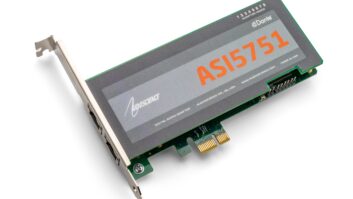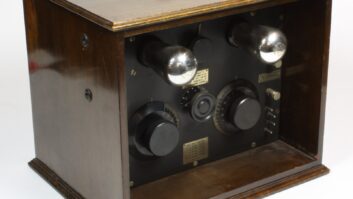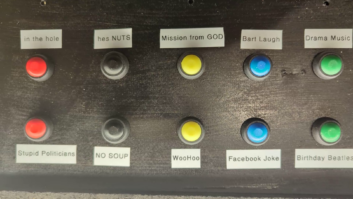
A good set of earphones is essential for the creation of quality audio, whether that audio is produced in the studio or in the field. The field has its own set of challenges: Not only must the producer, talent and engineer hear the audio being produced through the headphones, the headphones must isolate the wanted signal from the unwanted ambient sound. In most instances, that would involve taking studio headphones (and adapters for recorders, laptop, etc.) into the field. Sometimes one cannot use a set of headphones in the field.
Where I usually work (racing pits, garage areas, victory lanes, noisy press rooms, other field situations — you get the picture), one needs to hear ambient sound along with that made by the recorder or broadcast link, and headphones often are not appropriate in that situation. They take up too much room in a news kit, too.
How does one get the headphone quality in a small package? Simple and small ear bud-style earphones fit in the ear, but typically one does not hear the full range of audio.
Isolation
The Future Sonics Atrio m5 is the latest iteration of its line of canalphone-style earphones. Canalphones fit tightly into the ear canal. The m5 was developed for on-stage performers who needed the isolation one gets from a set of over-the-ear or circumaural headphones, but without the geeky look that headphones might provide.

The m5 (onyx black) is part of a line of variously colored receivers (m3 earth beige, m8 cobalt blue, m9 ruby red), with the same audio specifications. They were designed to be light so that the canalphones would fit comfortably in the ear canal while maintaining the proper coupling to the canal that is critical for best performance.
The m5 comes with assorted sizes of silicone ear tips and foam tips, along with a cleaning tool to dislodge cerumen — ear wax — that may build up in the ear tips.
I used the medium silicone ear tips for this evaluation. They go much further into the ear canal than bud-style headphones.
The closest comparison I can make is to say that they feel somewhat like the experience one gets when one would use a silicone ear tip for a monitor ear piece in the ear. The foam earpieces felt most familiar to me, because I use those style of earplugs near loud engines, to block out loud engine noises.
The Atrio line is designed so that the connecting cord (1.3 meters long) hangs down and can be routed over the ear and down the back or may be worn hanging down like traditional commercial earphones. The m5 has a 3.5 mm (1/8-inch) stereo connector and 32 ohm impedance. I used a generic 3.5 mm to 6.3 mm (1/4-inch) connector and found no problems.
The Atrio m5 does not use an armature design for the transducers. An armature design describes that which is normally used in a hearing aid. These designs are efficient when reproducing voice frequencies, but not so efficient when attempting to reproduce bass frequencies. Future Sonics once used armature designs but discontinued those designs once they perfected their development of miniature dynamic loudspeakers, which are the transducers used in the m5. The published specifications suggest a frequency response of 18 Hz–20 kHz with a sensitivity of 112 dB at 30 Hz at one milliwatt of power.
Bass response with the m5s seemed to be a function of how well the monitors fit in the ear canal, hence the different inserts. The bass frequencies that one might not hear with a pair of Walkman-style or ear bud headphones are heard with the m5.
Bass
Case in point: I played a copy of Crosby, Stills and Nash’s “Southern Cross” through my Behringer UB802 mixer. One hears the distinctive bass with a set of headphones. With ear buds, not so much. With the m5s, the bass comes through. I noticed that it took a few tries working with the Atrio m5s before I was able fully to understand and process the sound I was hearing.

One must be careful with the sound levels. Future Sonics suggests users of these canalphones start with a low volume level and flat equalization and then increase the volume while leaving the tone control alone. The sound level one would use working with conventional ear buds (and even some over-the-ear headphones) may cause discomfort so, as with any earphone, gradually increase your volume to a comfortable listening level with the Atrio m5.
Future Sonics is recognized by H. E. A. R. (Hearing Education and Awareness for Rockers; www.hearnet.com) and the company does work to promote safe monitoring practices.
The Atrio m5s block enough of the ambient sound (published specifications suggest a 26 dB reduction), that, for instance, the earphones can be used to evaluate audio on a laptop if you are flying. They work with a BlackBerry, too. I was able to evaluate audio while a motel room TV was playing six feet from where I was sitting. During a news conference, I had to make a quick sound check on audio being recorded on a Marantz PMD620. I simply plugged in the Atrio m5s and made the evaluation. Ear bud earphones would have let too much of the ambient sound through in that instance and I could have missed a problem with audio levels. That saved time, and saved a recording. They work even better when the ambient noise is much lower.
The manufacturer’s suggested retail price for the Atrio line is $199.95. The m5s come with a belt-sized carrying case for the m5s, silicone and foam ear tips, cleaning tool and enough room for a 3.5 mm to 6.3 mm adapter.
A $200 set of canal-style headphones might cause a stir amongst the green eye shade people in accounting departments. The question that should be asked: How much are your ears worth? If a person can use the m5 to process audio at a safe level, and not have to file future insurance or other claims for on-the-job hearing loss, maybe that expense looks better over time.
Paul Kaminski is the news director for the Motor Sports Radio Network, a contributor for CBS News, Radio, a Radio World contributor and Radio Road Warrior Columnist. His e-mail is[email protected].












